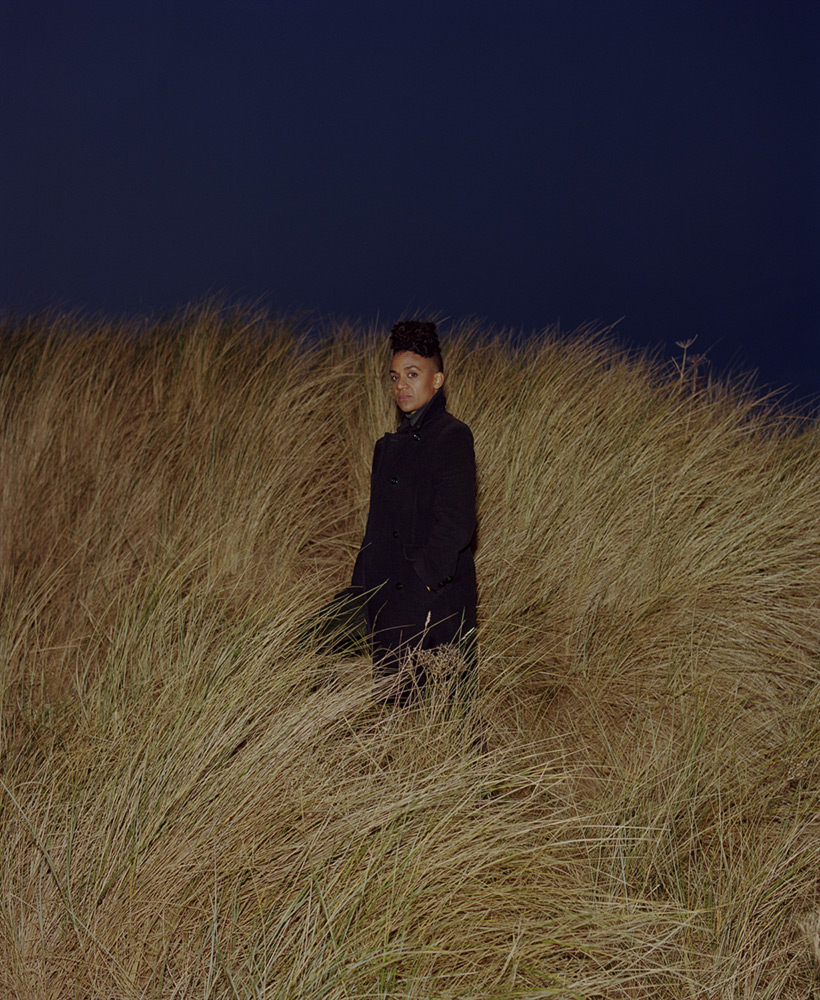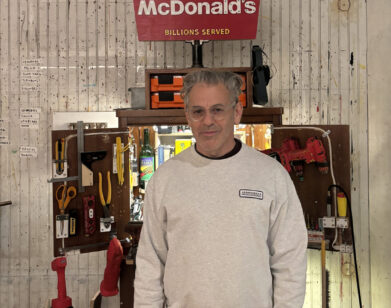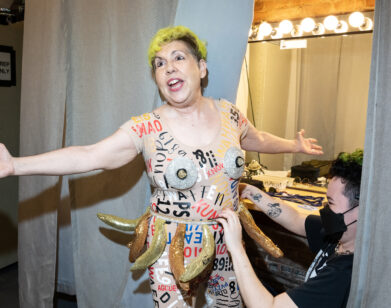Kapwani Kiwanga’s Archival Explorations
KAPWANI KIWANGA IN NEW YORK, NOVEMBER 2015. PHOTOS: VICENTE MUNOZ. STYLING: ALPHA VOMERO/SEE MANAGEMENT. HAIR: HANJEE/JED ROOT. MAKEUP: SIMONE OTIS/JED ROOT. JACKET AND PANTS: ELLERY. SHIRT: STYLIST’S OWN.
Dissecting information from archival documents and found footage is an inherent aspect of artist Kapwani Kiwanga’s practice—but not everything remains factual. For example, since 2011, the Ontario-raised, Paris-based artist has been producing an ongoing project entitled Afrogalatica that showcases various approaches to art (film, installation, performance) through quasi-scientific methods. She mixes fact with fiction, presenting a speculative future based on an Afrofuturist history. With her latest project, The Secretary’s Suite, which will be on view at the Armory Show beginning tomorrow, Kiwanga focuses upon an image of the UN Secretary General’s office in 1961. Though the year 1961 is a significant one in UN history (Secretary General Dag Hammarskjöld was mysteriously killed in a plane crash September 1961, and subsequently succeeded by U Thant), Kiwanga says, “it wasn’t the year itself but really that image, and it happened to be taken in that year.” The gifted objects within the photograph, found through research done after visiting the UN Headquarters and viewing a collection of gifted objects and artworks, led her to create a video (less than 10 minutes in length), immersive installation, and limited edition screen print to benefit the Museum of Modern Art.
As a whole, The Secretary’s Suite explores the idea of gifting as a form of exchange. Countries that are part of the UN frequently donate objects or works of art, which are then displayed within public spaces, the Secretary General’s office, and stored privately elsewhere. Kiwanga evokes questions regarding how an exchange can create or ruin a relationship, and how the concept of gifting attains different significances in various cultures.
In addition to Afrofuturism and examining the UN’s history of exchange, Kiwanga has explored other topics, such as the Maji Maji War—the largest uprising in 20th century African history. Before The Secretary’s Suite goes on view as the sole commission for the Armory’s 2016 Focus: African Perspectives, we spoke with the artist over the phone.
EMILY MCDERMOTT: So you first visited the United Nations art collection this past December. How did you come to that as a starting point?
KAPWANI KIWANGA: I didn’t visit the collection per se. I just saw what was available to the general public. When they go for a tour of the UN they see some objects that were donated at different occasions by different countries. I had gone to the UN with a different project idea in mind for the Armory, and when I got there I was interested in this question of gifting and diplomatic protocol. I kept thinking about this and it developed into the project for the Armory.
MCDERMOTT: What was the original idea?
KIWANGA: The original idea was more of a historical anecdote, about a president who had come to give a talk at the UN and was limited to a certain area in New York. There’s a question of the UN being territorial, a question of different territories and statutes of nations. It’s an anecdote which I still find interesting but the objects that were displayed really opened up a door for thinking about the question of exchange more generally. The starting point was really the question of diplomatic gifts and the UN, but the project branched out to more general questions of exchange between people, nations, and time periods as well. In my work I often look at very large temporal structure, so it can be prehistory to our present, but also going into a speculative future. I like the fictional aspect of things, but I wouldn’t say futuristic so much. So speculation, to allow for imagination and creativity in a basic sense. I really want to explore all types of gifts that are given, even the most mundane, and those that are not necessarily on [public] display. The list of UN objects is not publicly available yet, but they are making a repository.
MCDERMOTT: What are some of the more mundane things that attracted you?
KIWANGA: For the UN specifically, there isn’t anything I can speak of, but research beyond the UN, I was looking into diplomatic gifts and museums here in France. It could be things, like knitted socks, it could be food—these gifts that are given not only by diplomats but also by the general public, out of admiration or respect. There’s this wide range of gifts given, sometimes in a political context, sometimes in a more amicable or appreciative gesture.
MCDERMOTT: What are some of the fictional objects you’re going to bring into the installation?
KIWANGA: When there’s information I’ve not been able to research to find concrete answers, I propose different scenarios. It’s thinking of objects that could have been gifted to the Secretary in the context in which that happens. The actual situation of the Secretary’s death in the plane crash has been the object of speculation, through conspiracy theory and serious inquiries from the UN on different occasions, trying to look into what happened. It was quite mysterious. That’s a space where quite a lot of speculation that comes about.
MCDERMOTT: What is your research process like, and at what point do you start speculating?
KIWANGA: It’s different each time. This particular project goes back and forth; I’m always accumulating really factual information. The majority of what I do is [based from] documents, archives, and factual information. There are moments when I find that a bit too dry or closed, and those are moments where there needs to be some openness to break the narrative into something more open ended and questionable. Those moments, I think I need to insert some speculative, or imaginary, or fictive part. It’s not so much the objects or the theme, it’s how everything works formally as a whole, in the end.
MCDERMOTT: Have you faced any difficulties accessing information from the UN? I imagine there’s some red tape.
KIWANGA: That’s part of any research I suppose. There are projects that adapted because of that, [although for this project] I would say red tape, yes, partly, but it’s more the time frame and bureaucracy. There’s a lot of people involved, because a lot of countries gift objects and there’s an art counsel. Had I come across this project idea earlier, then maybe I would’ve been able to go through [more within] the time frame it takes to get responses. I was able to speak to some people who were very honest and said, “Our time frames are usually two months for this, or three months for this,” and I needed to work on a time frame which was a more quick. I think the art world and the diplomatic world have different paces.
MCDERMOTT: I imagine you’ve learned so much doing research for this project, but what was one of the more surprising things?
KIWANGA: I don’t know if it’s the most spectacular thing… Local museums that I found in Canada, in fact, are where a Presidential Prime Minister or political leader has donated or opened a museum based on his collection. The museology around that I find quite interesting. Coming across all these small museums that display just the diplomatic gifts given to one person during one term of office I find quite interesting. That was something I hadn’t thought of exploring at the beginning but I came across.
MCDERMOTT: With the UN collection, each country is technically only supposed to give one gift, but of course they have given more. What do you think of that policy?
KIWANGA: In my research I’ve found that nations give gifts all the time. Whenever they meet, they’ll give a new gift. The idea of giving only one gift is surprising because gifts are given at the anniversary of 25 years being part of the UN or 50 years of a specific event in one country’s history, and continual gifts that are given, from the same nation in the end, but in different contexts and for different reasons.
MCDERMOTT: How do you feel about gift giving in general?
KIWANGA: What I find interesting about the idea gift giving is this idea of how exchange really ties people together in some form of relationship. Also, how culturally different that process and act is, how binding it is in different cultures. Not giving a gift in one culture could be disastrous, whereas in another place it may not be so important. Meandering through different perspectives, be it cultural or temporal, allows us to see how the importance—political, sociological, economic—can link to this whole process of exchange. It’s, for me, the question of relationship through exchange, more than gifting.
MCDERMOTT: What about the religious aspects inherently associated with exchange, like offerings?
KIWANGA: The questions of offerings are quite interesting. One of the things I find interesting is giving materially to buy oneself time in heaven, or to repay sins. It’s interesting that the religious institution sets up a model in which you can give in order to somehow redeem oneself but at the same time create a social system that is more balanced. You’re right to point out the offering—the offering is more spiritual than religious to me—and the religious, which is linked to those institutions and giving a percentage of your wealth. These ideas of how religion and spirituality have taken that idea of gifting is quite important.
THE ARMORY SHOW WILL BE ON VIEW MARCH 3-6, 2016. FOR MORE INFORMATION, CLICK HERE.







